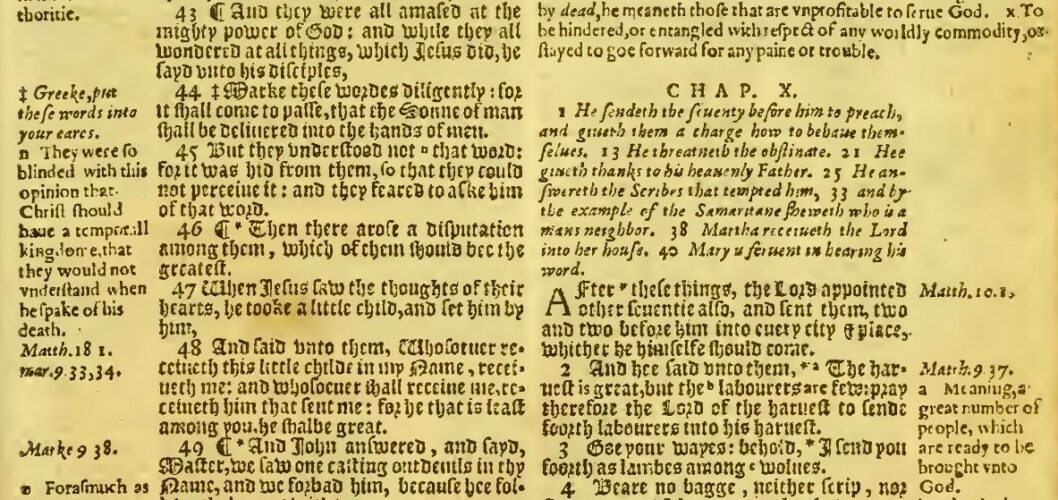Review of Terry L. Johnson, The Parables of Jesus: Entering, Growing, Living & Finishing in God’s Kingdom, Fearn: Christian Focus Publications, 2007, 2010, paperback, 438 pages including a bibliography of works cited as well as subject and Scripture indexes.
 How often do you hear people use Jesus’ words in the Sermon on the Mount regarding “going the second mile” by applying them to an individual doing more than was expected for a job or service (Mat 5:41)? How about someone saying, possibly sarcastically, “Oh ye of little faith,” to colleagues doubting the ability of the speaker to accomplish a task (Mat 8:26)? Then there are the three words from 1 John 4:16 that constitute the entire doctrine of God for some individuals, “God is love.” What about the parables? The Prodigal Son is mentioned commonly with reference to wayward children (Luke 15:11-32). The Rich fool’s “eat, drink, and be merry” is popularly interpreted to party now for we are hell bound anyhow (Luke 12:13-21). Then there is the parable probably most often alluded to by popular culture, The Good Samaritan (Luke 10:25-37). A good Samaritan is one who enters a questionable, even dangerous situation to help or rescue others. We can be truly grateful for good Samaritans that help in times of need, but the popular use of the term does not present the fullness and purpose of Luke 10:25-37. In all these examples there is truth in the way the passages are used, but the truth is viewed out of focus and distorted because an understanding of the biblical context and flow of redemptive history are not ground into the lenses of interpretation. The nonbeliever using these Bible passages recognizes to some degree the truth of the Bible’s teaching but without the interpretive spectacles accompanying redemption the passages are misunderstood as borrowed capital (Cornelius Van Til). Scripture tells Christians to search the Scriptures daily and seek out faithful teachers in order to understand correctly the Bible’s message (Acts 17:11; 8:26-40). Faithful teaching should come first through one’s church, but then for further study or preparing lessons for Sunday School or a Bible study, Terry Johnson’s The Parables of Jesus: Entering, Growing, Living & Finishing in God’s Kingdom is a good source sensitive to the context of parables and it provides principles for application. The author has been the senior pastor of Independent Presbyterian Church, Savannah, Georgia, for a number of years and built his ministry upon a foundation of expository preaching.
How often do you hear people use Jesus’ words in the Sermon on the Mount regarding “going the second mile” by applying them to an individual doing more than was expected for a job or service (Mat 5:41)? How about someone saying, possibly sarcastically, “Oh ye of little faith,” to colleagues doubting the ability of the speaker to accomplish a task (Mat 8:26)? Then there are the three words from 1 John 4:16 that constitute the entire doctrine of God for some individuals, “God is love.” What about the parables? The Prodigal Son is mentioned commonly with reference to wayward children (Luke 15:11-32). The Rich fool’s “eat, drink, and be merry” is popularly interpreted to party now for we are hell bound anyhow (Luke 12:13-21). Then there is the parable probably most often alluded to by popular culture, The Good Samaritan (Luke 10:25-37). A good Samaritan is one who enters a questionable, even dangerous situation to help or rescue others. We can be truly grateful for good Samaritans that help in times of need, but the popular use of the term does not present the fullness and purpose of Luke 10:25-37. In all these examples there is truth in the way the passages are used, but the truth is viewed out of focus and distorted because an understanding of the biblical context and flow of redemptive history are not ground into the lenses of interpretation. The nonbeliever using these Bible passages recognizes to some degree the truth of the Bible’s teaching but without the interpretive spectacles accompanying redemption the passages are misunderstood as borrowed capital (Cornelius Van Til). Scripture tells Christians to search the Scriptures daily and seek out faithful teachers in order to understand correctly the Bible’s message (Acts 17:11; 8:26-40). Faithful teaching should come first through one’s church, but then for further study or preparing lessons for Sunday School or a Bible study, Terry Johnson’s The Parables of Jesus: Entering, Growing, Living & Finishing in God’s Kingdom is a good source sensitive to the context of parables and it provides principles for application. The author has been the senior pastor of Independent Presbyterian Church, Savannah, Georgia, for a number of years and built his ministry upon a foundation of expository preaching.
Following Pastor Johnson’s introduction in which he discusses various opinions among scholars regarding the definition of a parable and exactly what the purpose of parables as a genre is, he gives expositions of nearly thirty parables with each one including study questions at the end of the chapter. The author classified the parables under four categories–Entering God’s kingdom–includes parables of faith, repentance, conversion, decision and commitment; Growing in God’s teaching–includes parables of growth and the environment of growth for individuals and the church; Living in God’s kingdom–includes parables of the Christian life–word, prayer, love, forgiveness, outreach, discipline, and restoration; and finally, Finishing in God’s kingdom–are parables of the end and final judgment. As the author notes, the lines between categories “are fluid” in that parables often overlap the categories, but he adds that parables provide a unique Kingdom-oriented perspective on Jesus’ stories. His purpose was to present the parables “as a theology of the Christian life” using “a book of stories about life as Jesus would have us live it” (7). Parables are an effective method of teaching used by Jesus to present the spiritual principles of the Kingdom because their vividness grabs the attention of listeners. Parables also, as Jesus told the disciples, have the two fold purpose of concealing and revealing–concealing from those not of the Kingdom, but revealing to those who are Kingdom members. The chapters are straight forward and composed with the average Christian reader in mind. A copy of Johnson’s The Parables of Jesus will provide any pastor, teacher, or person seeking a devotional book for personal study with a theologically reliable and readable source.
Barry Waugh
Notes–The copy of the book used for this review was purchased by the reviewer. The header is the Geneva Bible’s beginning of Luke 10 which includes the parable of the good Samaritan. The popular and general view of the meaning of the Good Samaritan used in the review is what the writer of the review believes to be the interpretation generally accepted by the public and many Christians. Terry Johnson brings out the meaning of the parable for a Christian to understand with the immediate and extended context providing a richer understanding.





